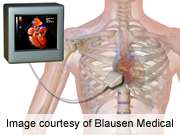Appropriate use criteria established for pediatric ECHO

(HealthDay)—Appropriate use criteria have been developed for the initial use of transthoracic echocardiography in outpatient pediatric cardiology. The guidelines were published online Sept. 29 in the Journal of the American College of Cardiology.
In an effort to help clinicians in the care of children with possible heart disease, Robert Campbell, M.D., from the Emory University School of Medicine in Atlanta, and colleagues established and evaluated appropriate use criteria for the initial use of outpatient pediatric echocardiography.
The researchers identified 113 indications based on common clinical scenarios and/or published clinical practice guidelines; these indications represented most of the possible uses of echocardiography in the outpatient pediatric setting. The indications were classified into one of nine categories of common clinical presentations, such as palpitations, syncope, chest pain, and murmur. Each indication was evaluated using a scoring scale of 1 to 9 to rate appropriateness. The researchers found that 53 indications were classified as "appropriate," 28 as "may be appropriate," and 32 as "rarely appropriate."
"The goal is to familiarize both pediatricians and pediatric cardiologists when echocardiography may help a physician elucidate a quicker diagnosis and when other diagnostic pathways may be more useful," Campbell said in a statement.
Several members of the rating panel and reviewers disclosed financial ties to the medical device industry.
More information: Full Text
Copyright © 2014 HealthDay. All rights reserved.



















